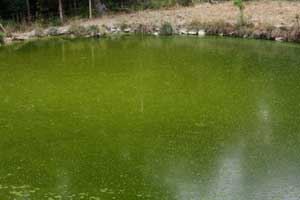Algal Blooms Pose Danger To Livestock
LEXINGTON, KY.
Recent news reports of unsafe drinking water in the Great Lakes area
has drawn national attention to toxic algal blooms. In Kentucky,
cyanobacteria, also known as blue-green algae, recently were found in
Green River Lake, Taylorsville Lake, Barren River Lake, Nolin Reservoir
and Rough River Lake at levels that prompted a recreational advisory.
Algal blooms are accumulated populations of algae in freshwater and
marine water environments. They can reduce water quality, so animals
might not drink as much as they need to get them through the hot, dry
summer. Of the more than 2,000 species of blue-green algae identified,
at least 80 are known to produce cyanotoxins (poisons) that can
seriously affect animal and human health.
“Although algal blooms can occur at any time of the year, they happen
most often in the warmer months of June through September,” said
Michelle Arnold, ruminant veterinarian for the University of Kentucky
College of Agriculture, Food and Environment. “In freshwater, the
majority of harmful algal blooms are caused by cyanobacteria.”
Blue-green algae naturally exist in wet places. They thrive in warm,
stagnant, nutrient rich water and are found often in ponds, lakes and
slow moving rivers.

Anderson County pond
PHOTO: Jeffrey Lehmkuhler, UKAg beef specialist
While not all algae are harmful, farm ponds contaminated with
fertilizer runoff or direct manure and urine are the perfect environment
for harmful blue-green algae. When the weather is hot and dry, rapid
growth of the algae can result in a “bloom,” or a build-up of algae that
creates a green, blue-green, white or brown coloring on the surface of
the water. It may look like a floating layer of paint. If it’s windy,
the algal blooms may concentrate along the water’s edge, which increases
the risk for livestock to ingest the algae when they come down to the
pond for a drink.
“Environmental factors such as water temperature, sunlight, water pH
and nutrient concentration all affect when toxins will be produced,”
Arnold said. “Cyanotoxins can affect the liver and nervous system and
have been implicated in illness and human and livestock death in at
least 35 states and in more than 50 countries worldwide.”
Animals that consume affected water may die suddenly or suffer from
weakness, staggering or photosensitization depending on the toxin and
how much they ingested.
A few simple steps can keep livestock, pets and humans safe from
algae poisoning. Always assume that a blue-green algal bloom is toxic.
Provide clean, fresh water to animals and fence off their access to
stagnant, scum-covered ponds.
“Fencing off natural water sources and providing alternative water
sources really is your best option,” said Amanda Gumbert, UKAg extension
water quality liaison. “Don’t allow your animals to contaminate the
water with feces and urine. Prevent fertilizer or manure runoff from
entering water sources. Phosphorus is particularly important in fueling
cyanobacteria growth.”
If the water source is treated with an algaecide such as copper
sulfate, prevent animal access for at least a week to allow degradation
of any released toxins in the water. It is best to wait until ponds are
no longer stagnant before allowing animals to drink from it.
“Creating and maintaining natural buffers, such as trees and shrubs
between farmland, housing developments and waterways can help filter out
excess nitrogen and phosphorous before they reach the water,” said
Steve Higgins, director of environmental compliance for the UK
Agricultural Experiment Station.
To protect humans, don’t swim in water with scum layers or blooms and
avoid jet skiing, windsurfing, tubing or water skiing over scum or
blooms. Don’t use untreated water for drinking, cleaning food or washing
camping gear. Boiling water will not remove algal toxins. Thoroughly
wash any skin that comes into contact with a bloom. Don’t eat shellfish
caught or harvested from a bloom area.
Farmers who notice algal blooms in ponds intended for livestock use
should get the water tested. Not all algal blooms produce toxins.
“Many algal blooms in Kentucky are composed of harmless green algae
that may look like underwater moss, stringy mats or floating scum,”
Gumbert said. “It is impossible to tell just by looking at the pond if
it contains blue-green algae.”
The UK Veterinary Diagnostic Lab can accept water samples and forward
them to referral labs to identify blue-green algae and test for toxins.
Visit http://vdl.uky.edu/TestInformation.aspx and search under “Toxicology” for further information regarding sampling and pricing.
“Unfortunately, testing water for an actual toxin is problematic,
because toxins are not uniformly distributed in the water source,”
Arnold said. “Testing can be quite expensive and there are many
blue-green algae toxins for which no diagnostic tests exist. To be safe,
always assume that a blue-green algal bloom has the potential to be
toxic.” ∆